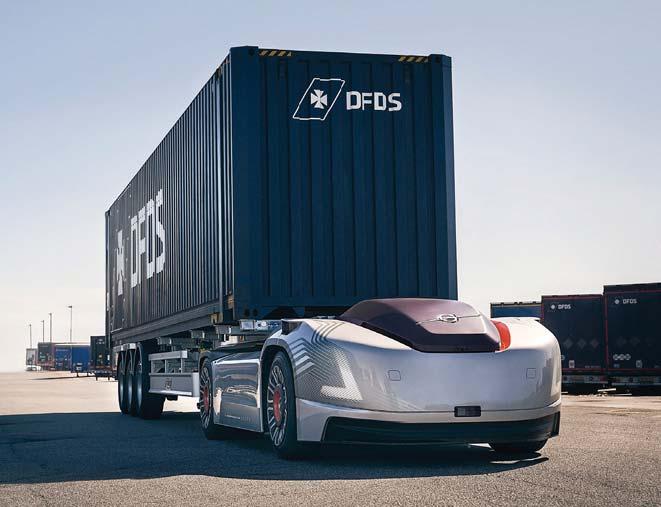
25 minute read
Thought leadership
Should Defence be investing in developing autonomous combat logistic vehicles?
By Major Rachel Gibbs
Much has been said and written about automation. We often see news stories about Amazon, Ocado and other logistic companies developing automated warehouses and the automotive industry developing driverless vehicles. Safety, cost efficiency and climate change are behind this, but how much is Defence getting involved in the revolution?
This article will focus on the distribution aspect of logistics, particularly the last mile of resupply to frontline troops and analyse the pros and cons of automation, before outlining what projects Defence is currently undertaking. And I ask… should we be pushing to automate combat resupply or are there higher, more appropriate priorities?
Why would we automate?
The immediate response most people would give when asked: ‘Why would we automate the distribution of combat supplies on kinetic operations?’ It is because it could reduce the risk to soldiers' lives. Indeed, in the UK Doctrine, Robotics and Autonomous Systems in Military Support (RAS), the aim of using automation is to: “reduce the physical and cognitive burden on the serviceperson to increase endurance, persistence and reach to enable sustained operations in degraded and austere environments.” 1
If driverless vehicles deliver combat supplies to frontline troops, the soldiers that would have been driving the logistic convoys are not exposed to that high-risk environment and become available to conduct other duties. This is a valid argument, yet there are numerous other considerations to look at.
Humans need rest to avoid making mistakes that can ultimately lead to injury or worse. This limits the speed at which they can distribute supplies. Automated vehicles do not have these constraints. They could go further, faster, expanding operational reach and improving speed and
Credit AB Volvo
efficiency of resupply. Automated resupply could be far more agile and resilient than traditional methods, resupplying little and often by using single vehicle moves, rather than waiting for demand levels to make a convoy worthwhile. By lowering the risk, the threshold for benefit would be lower in the risk vs benefit trade off calculation. This could give greater flexibility to combat troops, allowing them to go deeper into enemy territory for longer with confidence that they will have logistic support.
So there may be some benefits from automating the way we resupply the frontline. However, it also raises a plethora of issues. Without resupply, combat troops cannot function effectively for longer than a day or two, making resupply a high value target for the enemy. Resupply convoys are extremely vulnerable and therefore armed protection of the logistic convoy is paramount. The current standard operating procedure for logistic convoys operating in contested combat environments involves each vehicle having a minimum of one soldier driving and a second on top cover. With unmanned vehicles, armed protection disappears: currently automated weapon systems that remove the human decision-making process on whether to fire are a no-go for the British Army due to the moral and legal questions they raise. Removing armed protection could make the logistic vehicles even more vulnerable to ground attack, irrespective of the fact they are driverless.
There is another huge advantage that soldiers can provide when engaged in resupply: situational awareness. During convoys, soldiers can collate huge amounts of information to report to their HQs: enemy numbers and locations, conditions of routes, the morale of friendly forces. This information can be invaluable to the battle picture. Automated vehicles do not have this capability, currently. In the future, technological advancements may produce sensors that can collect battlefield intelligence and distribute it to soldiers on the ground2. But as it stands, the human element provides a significant advantage that automated vehicles do not.
Why don’t we wait for technology to improve?
Numerous civilian companies are investing billions into researching and developing autonomous vehicles. Collectively this reaches far beyond Defence’s entire budget. With such disparity in what Defence can invest
when compared with industry, is it worth waiting for civilian companies3 to produce a product and then purchase directly from them? ‘Off the shelf’ purchasing is used for many other pieces of military equipment. To an extent, Defence is looking at this for automated logistics too – the MOD is currently conducting trials using driverless vehicles developed by civilian companies . However, the differences between the environments in which a civilian driverless vehicle will operate compared with autonomous combat resupply vehicle are vast. Civilian driverless vehicles are set up to operate in very rules-bound, specific and predictable conditions. Vehicles in a combat zone, however, are unlikely to have the same luxury of smooth roads with road markings and signs, and vehicles around all obeying rules of the road. Therefore, military vehicles will have much more complex decisions to make when operating autonomously. Waiting for civilian vehicle manufactures to be produce ‘off the shelf’ vehicles suitable for Defence to purchase could be too far in the future to be realistic. Therefore, work must be done that is specific to the combat environment – exactly what the team on project THESEUS are doing through the Joint Tactical Autonomous Replen and Resupply (JTARR) trials. JTARR is a DSTL-led project trialling the use of autonomous air and ground vehicles to deliver resupply to the front line across the so-called ‘Last Mile’. It encompasses factors including limitations of platforms currently available - such as what does a robot do if it gets a flat tyre, or if the network is compromised? - and reducing risk associated with automated vehicles in a contested environment4. This project is producing some really valuable information, but there is still a great deal of work to be done before we will see our fighting troops being resupplied by autonomous vehicles.
Why is Defence moving so slowly?
Financial cost will always be a limiting factor in almost everything Defence does. The cost of research and development is enormous and can often spiral if things do not go to plan. Yes, automation of logistics may reduce the number of soldiers required to conduct resupplies in the long term, freeing up soldiers for other tasks where personnel are in greater need; although people will still be required to manage and maintain the autonomous vehicles. However, by spending money now on development of these systems, it will take many years before we see the benefit, financial or otherwise.
Additionally, Defence projects must align with political direction and strategic aims. This relies on analysis of publications such as Global Strategic Trends and Future Operating Environment (FOE 35) in order to understand the potential threats that the UK may face in the future, with projects tailored to ensure effectiveness should those threats emerge. The analysis must justify the investment in a particular area or technology – if there is no need for a capability then there is no point wasting money on it, when the investment could have much more benefit when directed elsewhere. Analysis of the current RAS doctrine suggests that it is very much in line with deductions made from FOE 35 and other similar publications, pointing to a conclusion that Defence is tailoring its research and development appropriately, given its inevitable constraints. Yet there are aspects of the perceived threat that present much greater risk to human life than logistics resupply: for example, recces operating deep in enemy territory, or route clearance in areas with high likelihood of mines or IEDs. Would it be better use of Defence spending if we invested in automating these roles rather than our last mile logistics?
There are some potential advantages and clear disadvantages to the automation of logistic resupply in combat environments and with further technological advancements, these disadvantages may fade. Defence is putting a large amount of resources into research and development in this area and is making some critical progress. Is this enough? Ultimately, it depends on the reason as to why we are moving towards automation. If the goal is to reduce risk to human life, then we should press forward with this research and support it to fruition, but analyse closely if there are higher risk roles that would offer greater benefit than automation of logistics. If the goal is simply to do more with fewer soldiers, we may find that buying larger capacity vehicles or hitching trailers onto the back of our existing trucks is a quicker and cheaper option; releasing valuable resources that could have a greater benefit if invested elsewhere.
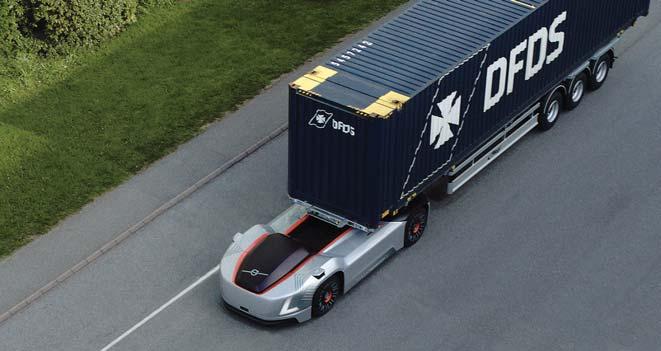
Credit AB Volvo
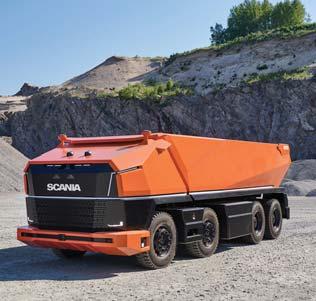
Credit: Dan Boman 2019, Scania
8 The level of investment required to
develop autonomous vehicles far exceeds Defence’s budget
8 Civilian driverless vehicles are set up to
operate in very rules-bound, specific and predictable conditions
Footnotes
1UK. Defence Logistics. Robotics and Autonomous Systems in Military Support, V3.1, (London:MOD, 2019), 8.
2Michael Klare, “The Coming of Automated Warfare,” Current History(Jan 2020): 9 3“Coalition Autonomous Systems – the future of military logistics,” Gov.UK, Sep 2019. https://www.gov.uk/government/news/coaliti on-autonomous-systems-the-future-ofmilitary-logistics 4“Coalition Autonomous Systems – the future of military logistics,” Gov.UK, Sep 2019. https://www.gov.uk/government/news/coaliti on-autonomous-systems-the-future-ofmilitary-logistics
Bibliography
United Kingdom. Developments, Concepts and Doctrine Centre. AGILE WARRIOR 2018/19 Annual Report.Shrivenham:
DCDC, 2019. United Kingdom. Developments, Concepts and Doctrine Centre. Global Strategic
Trends; The Future Starts Today,Sixth
Edition. Shrivenham: DCDC 2018. United Kingdom. Developments, Concepts and Doctrine Centre. Future Operating
Environment 2035. Shrivenham:
DCDC, 2015. United Kingdom. Defence Logistics.
Robotics and Autonomous Systems in
Military Support(V3.1). London:
MOD, 2019. Sung-Ho Hur, Chaeyoung Lee, Hong-Seung
Roh, Sebeom Park and Yosoon Choi.
“Design and Simulation of a New
Intermodal Automated Container
Transport System (ACTS) Considering
Different Operation Scenarios of
Container Terminals.” Journal of Marine
Science and Enggneering(2020): 1-19. https://doi.org/10.3390/jmse8040233 Michael Klare. “The Coming of Automated
Warfare.” Current History(Jan 2020): 9–14.https://doi.org/10.1525/ curh.2020.119.813.9 Tom Ryan and Viktor Mittal. “Potential for
Army Integration of Autonomous Systems by Warfighting Function.” Military Review (Sept-Oct 2019): 122-133. Torben Schutz and Zoe Stanley-Lockman.
“Smart logistics for future armed forces.”
European Union Institute for Security
Studies (EUISS)(2017): 1-4 doi: 10.2815/ 841308 Apthorp, Claire. “Using autonomy to supply the ‘last mile’.” Army Technology (June 2017), https://www.armytechnology.com/features/featureusing-
autonomy-to-supply-the-last-mile5852408/ (accessed 28 January 2021). Gov.UK. “Coalition Autonomous Systems –the future of military logistics.” Gov.UK. https://www.gov.uk/government/news/co alition-autonomous-systems-the-futureof-military-logistics (accessed 28
January 2021). Gov.UK. “Right On Time: Automating Military
Logistics.” Gov.UK. https://www.gov.uk/ government/publications/right-on-timeautomating-military-logistics (accessed 8 February 2021).
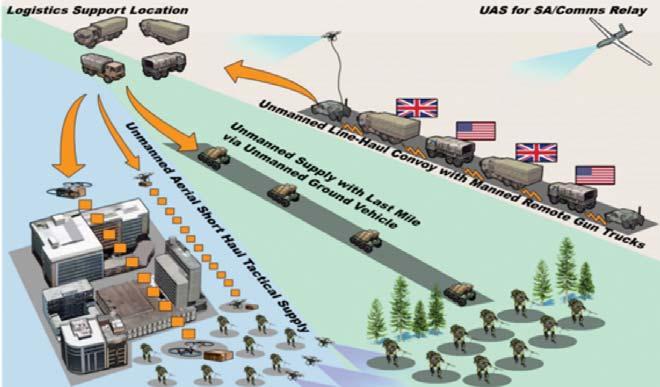
8 The JTARR project is trialling the use of
autonomous air and ground vehicles to deliver over the ‘Last Mile’
THE ROYAL LOGISTIC CORPS STRATEGY
We will professionalise and value our people, strengthen our ethos and maximise talent: We will embrace the opportunity for data-led technology enabled transformation:
• We will promote pride, ethos and belonging
• We will maximise the full potential of our diverse talent
• We will encourage innovative, inspiring leaders at all levels. • We will drive forward professionalisation including education and accreditation • We will accelerate trade modernisation to exploit cutting-edge technology • We will professionalise contract management PEOPLE TECHNOLOGY VISION becoming Defence’s recognised experts.
We will improve links with allies and partners to learn from others and
• We will develop our integration with the Defence Support community • We will enhance our relationship with industry and academia through the RLC Foundation.
the Corps, and wider stakeholders • We will showcase who we are and our enduring utility to the nation • We will improve how INTEGRATION COMMUNICATIONMISSION including society: we communicate binding together the whole of the Corps and wider RLC family.
WORLD-CLASS INNOVATIVE ADAPTABLE
The RLC in Ukraine
By Maj Mark Conlin SO2 Future Plans Op ORBITAL
Operation ORBITAL is a combined British and Danish Military Capacity Building mission. It is part of a multi-national partnership of NATO-member nations that delivers training support to the Armed Forces of Ukraine (AFU). The UK was the first of the partner nations to assist Ukraine after the start of the war with Russian-led separatist forces, over the highly contested Donbas region.
With around 250k personnel, but a budget of only $5.4 Bn (up from $2.8 Bn in 2014), the AFU has been under-resourced, struggled to cope with its own training burden and was held back by a post-Soviet structure and mindset. Ukraine now has its sights set on membership of NATO and the AFU has worked hard to restructure, refresh its doctrine and conduct training that contributes to interoperability with NATO forces.
Op ORBITAL is funded not by the MoD, but the Foreign, Commonwealth & Development Office’s (FCDO) Conflict, Stability and Security Fund (CSSF), which sets an important angle on the type of support that the UK military delivers. This training has ranged from urban operations to counter-sniping, mine-awareness and human security factors; but has also seen several deployments of RLC personnel to deliver bespoke logistics training courses. For example, in 2018, RLC soldiers delivered a suite of logistics packages at the Odesa Military Academy (OMA) that included ammunition storage, warehouse management, food services and fuel operator training.
2020/21 has seen a shift from providing individual training to train-the-trainer courses that are designed to pass capability development back to the AFU’s manoeuvre formations and training institutions. To achieve this, Op ORBITAL HQ has been upscaled to incorporate a Tri-Service contribution to capacity-building in Ukraine; the J5 team now has an SO2 Air (RAF), SO2 Maritime (RN) and an Army-tied SO2 Future Plans (currently Maj Mark Conlin RLC).
The AFU General Staff convenes Land, Maritime and Air domain sub-committees but also a dedicated Logistics sub-committee, co-chaired by Comd Op ORBITAL who is guided by the HQ’s RLC-tied Logistic Plans officer. This position is currently filled by Capt Stew Rutt RLC; his role is to analyse requests for logistic training support from around the AFU and to develop appropriate training solutions. He organised the logistic planning course that was delivered recently in the OMA by Capt Andy Nicholls and Capt Luke Edwards (both of 3 Regt RLC). This course covered
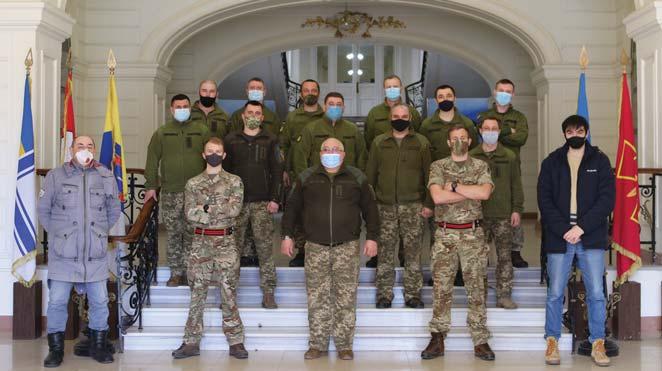

8 Maj Andy Nichols and Capt Luke Edwards (Odesa Military Academy)
UK/NATO operational CSS laydown and equipment capability as well as strategic outload/inload, RSOI and sustainment of operations.
A recent meeting with the Deputy Commandant of the National Technical University Military Institute of Armoured Forces will see the delivery in 2021 of a similar logistics planning course, plus an armoured fighting vehicle recovery and equipment support package, to familiarise the AFU’s tank formations with the UK/NATO Bde and Div logistic constructs.
Op ORBITAL will run until at least March 2023, supporting Defence Engagement activity including STTTs and a number of major multinational exercises each year. Notably, Ex COSSACK MACE (Jul 21) will see up to three sub-units from 4 SCOTS practise activation and breakout of equipment, then deploy by air and strategic RoRo to Ukraine, link up with a Ukrainian Army unit and conduct a Mech Infantry Battle Group FTX. This deliberate incorporation of strategic outload/inload and the maintenance of real-time logistic lines of communication is an important demonstration to our allies and our adversaries of the UK’s ability to deliver expeditionary warfare.
8 Maj Mark Conlin and Capt Stew Rutt (Kharkiv Armoured Warfare Institute)
Having left the Regular Army in summer 2019, WO2 (now Sgt in the Reserves) Laurie Taylor has been through the whirlwind experience of stepping into a new job with World Fuel Services (WFS), working for them in Lithuania at the height of the COVID-19 pandemic, while starting a reserve commitment with 158 Regt RLC.
“My first career in the Regular Army provided me with a wealth of transferrable skills for my new civilian role and the commercial experience with WFS has positioned me to make a telling contribution to the Army Reserves.
Conversely, my service, ethos and values as a reservist will benefit WFS. My last 18 months are a positive case study of the intended benefits from the MOD’s Whole Force by Design.
In July 2019, I was dined out from The RLC, having completed 23 years regular service as an RLC Pet Op, finishing as Warrant Officer Class 2. I decided to transfer directly over to the Army Reserves and join 158 Regt RLC, given the Unit’s footprint close to my home in Colchester. Whilst the transfer was taking place, I was still transitioning into civilian life; my main priority was to secure a full-time civilian job.
In August this was achieved. I took on the role of operations manager for the central and eastern Europe region with WFS. After
Whole Force by Design
By Sgt Laurie Taylor 202 Sqn, 158 Regiment RLC
conducting my training and probation in Afghanistan, where the company supports the NATO Resolute Support mission, I then deployed to Lithuania (Kaunas) as a civilian contractor. WFS supports the NATO Supply and Procurement Agency (NSPA) with fuel solutions for the enhanced Forward Presence (eFP) mission (at Rukla) and the Very High Readiness Joint Task Force - Land (VJTF-L) in the Baltics.
While in the Baltics, my role consisted of recruiting, training and managing a small team, while also conducting daily dialogue and gaining confidence of our customers; NSPA and the military end user. I was on a rotation of six weeks in country and two weeks on R&R. When the UK went into the first national lockdown in March 2020, I had just arrived back in Lithuania from R&R. Given the company’s mission imperative to support NSPA, as well as travel restrictions imposed by the UK and Lithuanian governments, I was to remain in country. While I had obvious concerns for my family in UK, I still had a job to do in Lithuania. The British Army has taught me to endure any challenge that you cannot control and just crack on. I adopted my trusted Army routine on tour, which I honestly think maintained my mental health; keeping fit, eating well and daily Facetime calls with my wife and two girls kept the pressures at bay. After a four-month lockdown in Lithuania, I was able to return home to the UK for much needed time with the family.
Throughout the lockdown in Lithuania, my team continued to support the NATO eFP mission. We faced a number of challenges as highlighted above. These revolved around: • Safety – This was paramount not just for myself but for my whole team and the customer. Writing risk assessments, implementing the company’s strict COVID protocols and conducting management checks were key factors to reducing potential risks during live operations for WFS operators and the customer. • Will – When the lockdown was announced, the team and I had to plan for worse case scenarios and potential threats to the company.
This type of planning was essential, as my mission was to enable ongoing operations and uphold our contractual responsibilities.
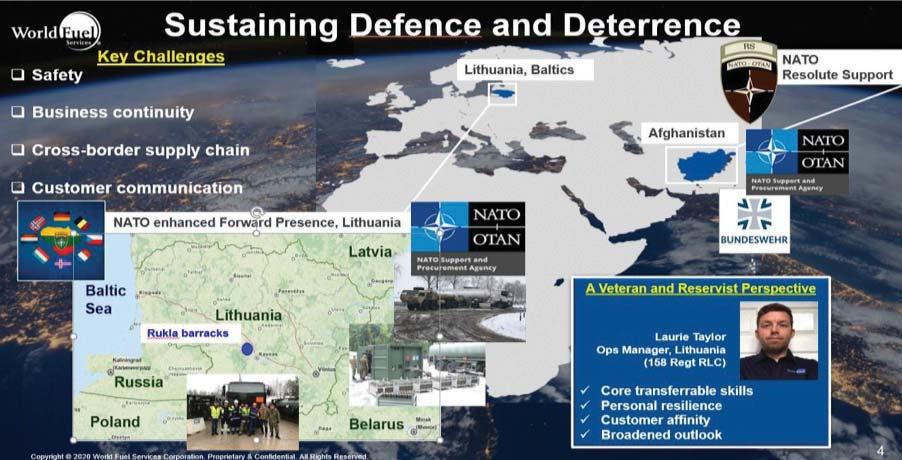
• Cross-border supply chain – An important part of our planning was to ensure that the borders were accessible to our supply chain, which stretched across the
Baltics down to Poland and up to
Finland. While there were challenges, working with NSPA and building a rapport with border authorities, good relations were critical to transiting borders easily. • Customer communications –
Truly understanding the customer’s needs and building a professional relationship are critical to my role.
While face-to-face meetings were difficult, I was able to interact with the customer on a daily basis using social media platforms like
WhatsApp and Zoom. It was business as usual!
The real-world experiences in the Baltics I describe will certainly help me in my role with 158 Regt RLC in military contingency planning and supply chain management. I have a much better appreciation of what a contractor requires from its customer.
When I look back on my military service, there are a number of transferrable skills that have helped me in my new civilian role as an operations manager: • Transferrable skills – Creating ideas, planning, leadership, people skills, time management and adaptability are just some of the key transferrable skills from my Regular Army service that have benefitted me. • Personal resilience - The military environment absolutely promotes personal resilience; I still use the
Army Values within my current role: courage, discipline, respect for others, integrity, loyalty and selfless commitment. • Customer affinity – Drawing upon my understanding and previous life as the military customer has really helped me support NSPA and its end users; especially in pre-empting their tactical-level needs. • Broadened outlook – Working in the energy industry has opened my eyes to the civilian sector.
Having an appreciation of all the corporate topics, its issues and being prepared ‘to speak truth to power’ is paramount.
Throughout the whole of the lockdown, 158 Regt RLC was still very much supportive. On my return to the UK, I explained my current role and responsibilities within WFS and expressed the commitment I could offer to 202 Sqn. With the assistance of the WFS Reservist policy, I am able to take 10 days paid leave for an Annual Deployment Exercise (ADE), attend all training nights, assured weekends and if required it allows me to mobilise. OC 202 Sqn identified that my current role with WFS would meet the job specification as the Operations SNCO. This involves organising and planning training events. I am also required to oversee troop management inspections ensuring that deadlines are meant for the OC’s quarterly reviews. I am confident that my experiences in Lithuania during the pandemic will be especially useful. Looking forward to 2021, my plan is to attend assured weekends and complete my ADE.
It has been an eye opening 18 months, but with the support of WFS and 158 Regiment RLC, my transition from Regular to Veteran/Reservist has been a great one.
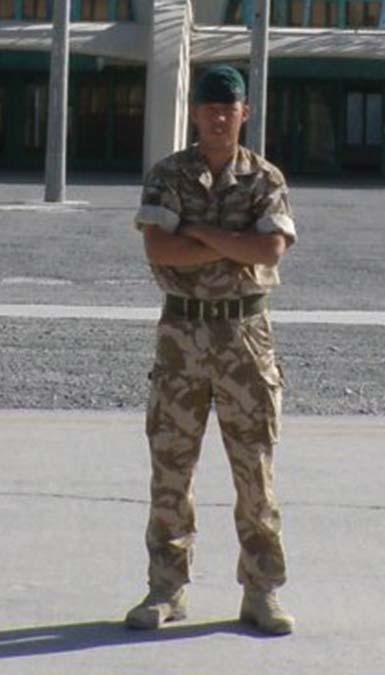
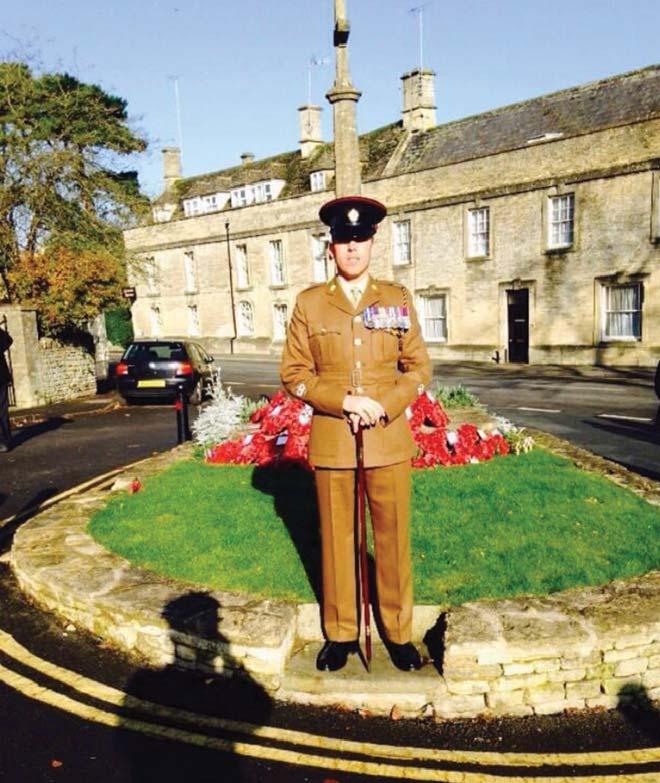
Overview of a war - Unique in nature, unexceptional in outcome. The problem was explained as a threat of tumbling dominoes. Post 1945, the world order was rapidly divided between two ideologies, communism and liberal democracy. One of the lines of this contest was drawn across South East Asia with a focus on Vietnam.
After the failed reintroduction of French colonialism in Indo-China in 1954, the US, under President Johnston, assumed the mantle of protector of democracy’s outposts. For Washington, a reserved policy of ‘graduated response’ resulted in an incremental force build-up which exacerbated its inability to take advantage of its superior firepower. Inflamed by the White House’s support of consecutive corrupt South Vietnamese governments, domestic political and social fracture lines eventually emerged, resulting in a total US withdrawal in 1975.
The chaos which ensued did not detract from the blood and treasure expended in what was categorised as a ‘Limited War’. Over 36 million helicopter sorties flown, more bombs dropped by the US than on Germany and Japan in WW2, over 50,000 US and 200,000 South Vietnamese killed and an estimated 1 million plus of North Vietnamese and Viet Cong. The Vietnam War’s legacy is still contested. It magnifies the narrow utility of limited wars fought against determined enemies, willing to take casualties on the ground of their choosing. Vietnam continues to provide insights for technologically advanced nations whose advantages can be nullified in the quagmire of close combat. In this sense, Vietnam is a close relation to Iraq and Afghanistan.
The Sources Background viewing/reading into the war What better place to start a campaign study than binge watching? Addictive, thought-provokingand often graphic, PBS America’s ‘The Vietnam War’ is groundbreaking. With over 18 hours of viewing, the documentary series analyses the conflict from the grand strategic decisions made in Hanoi, Washington and Paris to the
RLC Foundation campaign review
So begins PBS America’s 18-hour documentary series on the Vietnam War. This RLC Foundation campaign review provides an overview for those interested in studying the ‘First Television War’ and which arguably has connotations for recent conflicts. By Neil Llewellyn, The RLC Foundation
gut-wrenching close combat in conditions reminiscent of WW1 trench warfare. The series interrogates the war from both sides and although audiences are usually familiar with the issues from an American perspective, the miscalculations of the North Vietnamese politburo adds a new dimension in understanding the campaign. Whilst the seminal documentary offers an excellent introduction to the war, some targeted reading to supplement the 10-part series offers an opportunity to gain a deeper understanding of the war. (Viewer discretion advised contains mature content, strong language and graphic violence.)
Bernard Fall’s ‘Street Without Joy’ critically covers the French-Indo China campaign and in many ways provides an insight into the tragedy that was to come. Published in 1961 and revised in 1964, Fall, who was a soldier and then political science professor, covered the war from the ground until his tragic death in the field in 1967. Max Hasting’s ‘Vietnam’, picks up the baton and takes the reader from the French debacle into the US disaster. He blends the political machinations with the attritional actions and deftly illustrates the futility of many of the operational level objectives adopted by all the belligerents. Hastings also highlights the cultural chasms that prevented any understanding and progress of many of the regional initiatives whilst also contextualising the struggle within a much broader East-West contest. Jeremy Black’s section on Vietnam in his ‘A Century of Conflict’, expands on this global context and places the war into a specific time and space of the Cold War. The reader gains an understanding of how the defeat of French colonialism was overshadowed by a belief in Washington that the whole of Asia could fall under the control of a global communist movement. The presumption that ‘limited wars’ could be utilised to contain and incrementally undermine communism was pursued across the paddy fields of Vietnam in a largely ad hoc fashion with a flawed belief that overwhelming firepower would allow liberal democracy to prevail. The obvious flaws in the concept were not so obvious to the belligerents in 1959 and Black explains the incremental approach adopted by the belligerents. As for ‘how the war was sustained,’ the three offerings below provide some of the detail. Readers may be surprised on the scales experienced in this ‘limited war’ and in a footnote to history, the extent of the capacity building programme pursued by the US.
Further reading:
Mobility, Support, Endurance - Vice Admiral EB Hooper USN, published 1972. The US's logistics were so good they were largely invisible and therefore taken for granted. A detailed study from a naval perspective of Force sustainment and how it was achieved. Vietnam Studies – Logistic Support - Lieutenant General JH Heiser Jr, published 1974. Some surprising data which exposes how the US invested in cultural, economic and political initiatives – what we call ‘nation building’. A War of Logistics: Parachutes and Porters - CR Shrader, published 2015 Shrader’s books are ‘must reads’ for military logisticians. This brilliantly researched, eyeopening account should only be tackled by series students of the Indo-China wars.
The Royal Logistic Corps Foundation exists to foster the relationship between The RLC, industry and academia; sharing best practice, knowledge and mutual understanding amongst logistics professionals.
The RLC Foundation continues to run high quality virtual reality events and we hope to return to staging live events from August onwards. The Foundation Book Club continues to provide a focus for logistic publication reviews and we encourage members of the Corps to participate.
The RLC Foundation
RLC FOUNDATION EVENTS 2021 On 29 Apr 21, the Foundation co-hosted an event with the Worshipful Company of Carmen. This event focused on “Leading in Challenging Times: building resiliency in yourself and your organization”. It also addressed the question of: “how do we build the resilience mindset through leadership from the individual viewpoint and, crisis response resilience through process and capability?”
These topics were investigated from the academic, military and commercial perspectives. Guest speakers were: Professor Richard Wilding, Supply Chain Strategy, Cranfield University, Huw Jenkins, Chief Operating Officer, LCST Leidos Europe and Maj Gen Duncan Capps, Commandant RMAS. The event attracted 148 virtual attendees, the best attendance figures for a virtual event to date. If you haven’t had chance to see this excellent event visit: www.rlcfoundation.com/events
The RLC Foundation ran its TVS Supply Chain Solutions Career Transition Workshop for service leavers on 18 May 21. The event was aired on MS Teams from 1400 – 1600. There was an overwhelming response from service leavers which meant running a reserve list. The event was a unique opportunity for service leavers to get one-on-one advice about future job opportunities within the civilian workplace. TVS Supply Chain Solutions is a very supportive member of The RLC Foundation and have run very successful Career Transition Workshops in the past.
On 5 Aug 21, Ex LOG SAFARI will take place near Bicester. This event is very popular amongst the Foundation’s corporate members. It gives them the opportunity to engage with serving RLC soldiers and officers within a field force environment. Future details can be found on the RLC Foundation website nearer the event date.
On 9 Sep 21, World Fuel Services will host a seminar and operational capability event at RAF Northolt. This event is open to all corporate and military attendees, but will be of particular interest to RLC Petroleum Operators. Future details will be published on the website closer to the event date. 13 Air Assault Support Regiment is running a Military Planning event for the Foundation’s corporate membership on 30 Sep 21. This event will be staged within a simulated field force headquarters, with hands-on for our corporate members who will get to grips with military supply chain issues.
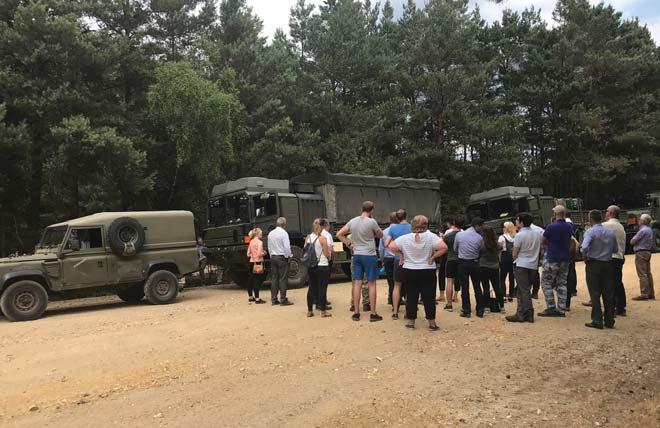
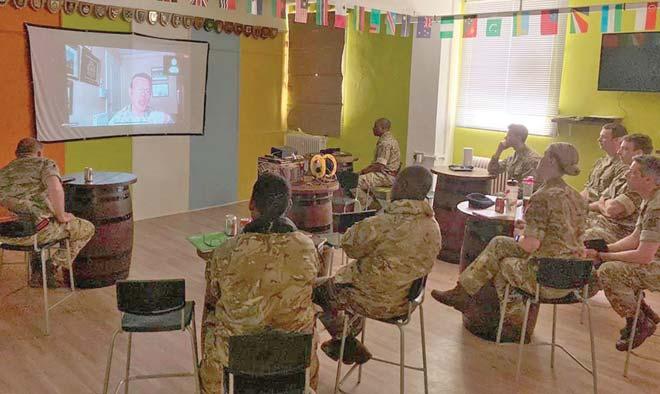
The RLC Foundation is now working from home. New contact details: Director: Alan Woods: rlcfwoods@gmail.com Business Support Manager: Chrissie Ross: therlcfoundation@gmail.com Follow us on LinkedIn and Facebook by searching for Royal Logistic Corps Foundation or visit our website: www.rlcfoundation.com










